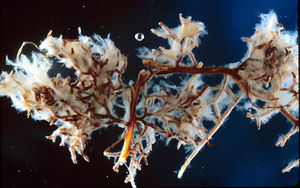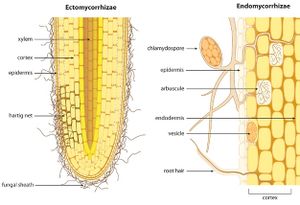Ectomycorrhizal Fungi

Ectomycorrhizal (ECM) fungi form symbiotic relationships with Plant roots. Only about 2% of the plant species on earth form endomycorrhizal relationships, but therein exist some of the most environmentally and economically important species. [1] EcM fungi tend towards specificity when choosing hosts, while Arbuscular Mycorrhizal Fungi is much more generalized in its choosing.
Structures

Mantle
A layer encasing the outside of the root tip in either a loose gathering or tight alignment of hyphae. The presence of the mantle can sometimes hinder root hair growth if the root is secured tightly.
Hartig net
A network of hyphae strands that work around epidermal and cortical root cells, as they make their way through the cortex towards the middle of the root. [4]
Extraradical hyphae
A fine network of hyphae that extend outward from the encased root, filling the role of the suppressed root hairs. By spreading out into the surrounding soil, the hyphae can extract water and nutrients for transport back to the root.
Fruiting bodies
The most recognizable part of an EcM relationship is the fruiting body. These growths are usually easy to spot with the naked eye. The function of the fruiting body is sexual reproduction to spread the fungus to new hosts.
Symbiotic relationship with plant roots
In order to attract and form an EcM relationship, plants release metabolites, or small molecules, that encourage hyphae to grow in the direction of the plant root. [7] Flavonoids are one example of a metabolite exuded by plant roots. [8] Once the hyphae approach and penetrate the outer membrane of the root cap, the fungus can begin to infect the plant. Even though the plant has essentially invited the fungus to infect its roots, some natural defenses still exist and resist the invasion by default for up to 21 days, in some cases. [3]
Relationship in action
Once the fungus has infected the plant roots and the epidermal cells, the mantle can form. Upon initial colonization, increased polypeptide synthesis has been observed. [9] Arguably the most important function of mycorrhizal fungi as a whole is its propensity to aid in the uptake of nitrogen. [10] Used in chlorophyll, enzymes, and amino acids within the plant, nitrogen is required for most vital bodily processes. Partnerships with mycorrhizal fungi allow for plants to have a leg up on competitors who do not have the privilege of fungi assistance to draw in more nutrients for use.
Process of nutrient transport
Nutrients are absorbed from the surrounding soil and transported to the plant roots through the use of three components. The interfaces essentially describe the fairly obvious flow of nutrients.
1: Soil-fungus interface
2: Fungus-apoplast interface
3: Apoplast-root interface
Once nutrients have reached the fungus-apoplast interface, the fungus keeps some of the acquired nutrients to maintain its own homeostasis. Up to 86% of the host's nitrogen requirements can be provided by the fungus, while keeping around 15% of the plant's net primary productivity. [11]
Role in spread of invasive species
Ectomycorrhizal fungi are more specialized in their formation of symbiotic relationships, so they are not hugely involved in the spread of non native species. That said, eucalypt and pine trees are obligate EcM trees and are often grown en masse on plantations, sometimes for commercial use. [5] In New Zealand, Pinus contorta has gained a foothold in natural ecosystems with the help of EcM relationships [6] Pinus contorta is native to the western United States and now compete with co-ocurring with native Nothofagus solandri var. cliffortioides.
References
[1] Tedersoo, Leho; May, Tom W.; Smith, Matthew E. (2010). "Ectomycorrhizal lifestyle in fungi: global diversity, distribution, and evolution of phylogenetic lineages" (PDF). Mycorrhiza. 20 (4): 217–263. doi:10.1007/s00572-009-0274-x. PMID 20191371.
[2] Dighton, J. "Mycorrhizae." Encyclopedia of Microbiology (2009): 153-162.
[3] Smith, Sally E.; Read, David J. (26 July 2010). Mycorrhizal Symbiosis. Academic Press. ISBN 978-0-08-055934-6.
[4] Carlile, M.J. & Watkinson, S.C. (1994) The Fungi. Academic Press Ltd, London. pp 329 - 340.
[5] Díez, Jesús. "Invasion biology of Australian ectomycorrhizal fungi introduced with eucalypt plantations into the Iberian Peninsula" (PDF). Issues in Bioinvasion Science. 2005: 3–15. doi:10.1007/1-4020-3870-4_2.
[6] Dickie, Ian A.; et al. (2010). "Co‐invasion by Pinus and its mycorrhizal fungi". New Phytologist. 187 (2): 475–484. doi:10.1111/j.1469-8137.2010.03277.x. PMID 20456067.
[7] Egerton-Warburton, L. M.; et al. (2003). "Mycorrhizal fungi". Encyclopedia of Soils in the Environment.
[8] Martin, Francis; et al. (2001). "Developmental cross talking in the ectomycorrhizal symbiosis: signals and communication genes". New Phytologist. 151 (1): 145–154. doi:10.1046/j.1469-8137.2001.00169.x.
[9] Hilbert, Jean-Louis; Costa, Guy; Martin, Francis (1991). "Ectomycorrhizin synthesis and polypeptide changes during the early stage of eucalypt mycorrhiza development" (PDF). Plant Physiology. 97 (3): 977–984. doi:10.1104/pp.97.3.977.
[10] Chalot, Michel; Brun, Annick (1998). "Physiology of organic nitrogen acquisition by ectomycorrhizal fungi and ectomycorrhizas". FEMS Microbiology Reviews. 22 (1): 21–44. doi:10.1111/j.1574-6976.1998.tb00359.x.
[11] Peay, Kabir G.; et al. (2007). "A strong species–area relationship for eukaryotic soil microbes: island size matters for ectomycorrhizal fungi" (PDF). Ecology Letters. 10 (6): 470–480. doi:10.1111/j.1461-0248.2007.01035.x.